
Overview of The Hunger Games Franchise
The Hunger Games franchise, based on the popular novel series by Suzanne Collins, has become a cultural phenomenon since its inception. Spanning across movies, novels, and merchandise, the franchise has amassed a significant fortune. In this article, we will delve into the financial success of The Hunger Games franchise, exploring its various dimensions.
Box Office Success
One of the primary sources of revenue for The Hunger Games franchise has been its movies. The series consists of four films, with the first two being the most successful. The first movie, “The Hunger Games,” released in 2012, grossed over $694 million worldwide. The sequel, “The Hunger Games: Catching Fire,” followed suit, grossing $864 million. The third film, “The Hunger Games: Mockingjay 鈥?Part 1,” brought in $711 million, and the final film, “The Hunger Games: Mockingjay 鈥?Part 2,” grossed $790 million. The total box office revenue of the franchise stands at approximately $2.9 billion.

Merchandise and Licensing
In addition to the movies, The Hunger Games franchise has generated substantial revenue through merchandise and licensing. The franchise has a vast array of products, including clothing, toys, home decor, and collectibles. The licensing deals have been particularly lucrative, with various companies producing official Hunger Games merchandise. According to a report by Statista, the global revenue from The Hunger Games merchandise and licensing deals exceeded $1 billion.
Novel Sales
The original novel series, which consists of three books, has also contributed significantly to the franchise’s revenue. The first book, “The Hunger Games,” was published in 2008 and has sold over 50 million copies worldwide. The second book, “Catching Fire,” was released in 2009 and has sold over 35 million copies. The final book, “Mockingjay,” was published in 2010 and has sold over 25 million copies. The novel series has generated substantial revenue through book sales, e-books, and audiobooks.
Television Adaptations
The Hunger Games franchise has also ventured into the world of television, with a prequel series titled “The 100.” The show, which aired on The CW network, follows a group of young survivors living in a post-apocalyptic world. While the show’s financial success cannot be compared to the movies, it has generated a dedicated fan base and has been renewed for multiple seasons. The television adaptations have added to the franchise’s revenue, albeit to a lesser extent.
Marketing and Branding
The Hunger Games franchise has been successful in creating a strong brand presence. The marketing campaigns for the movies have been extensive, featuring high-profile celebrities and a well-executed social media strategy. The franchise’s branding has extended beyond the movies, with various partnerships and collaborations. For instance, the “Hunger Games: Mockingjay 鈥?Part 2” soundtrack featured songs from popular artists like Ed Sheeran and Sam Smith, further boosting the franchise’s revenue.
Table: Financial Breakdown of The Hunger Games Franchise
| Aspect | Revenue |
|---|---|
| Box Office (Movies) | $2.9 billion |
| Merchandise and Licensing | $1 billion |
| Novel Sales | Over 110 million copies sold |
| Television Adaptations | Varies per season |
| Marketing and Branding | Varies per campaign |
Conclusion
The Hunger Games franchise has proven to be a financial powerhouse, generating billions of dollars in revenue across various platforms. From the movies to the novels, merchandise, and television adaptations, the franchise has captivated audiences worldwide. Its success can be attributed to its compelling storytelling, strong branding, and dedicated fan base. As the franchise continues to expand, it is expected to maintain its position as a leading force in the entertainment industry.